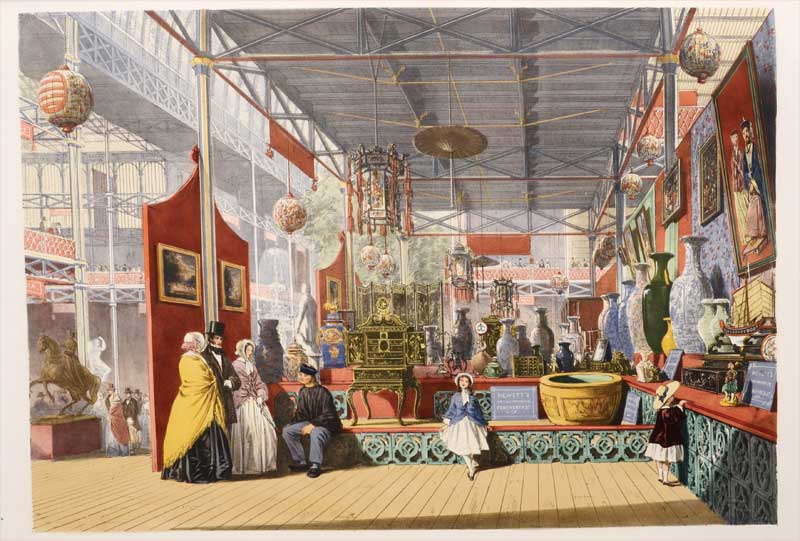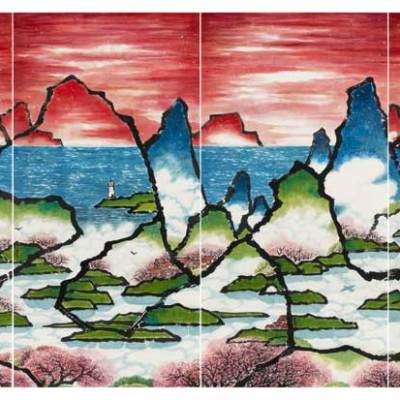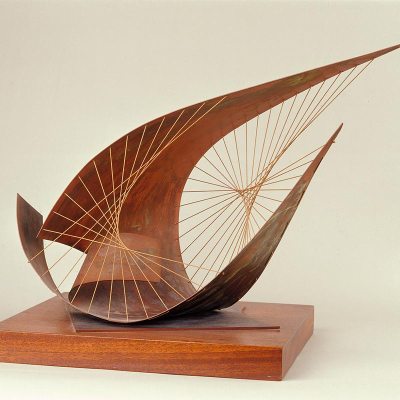The UK capital is celebrated at Masterpiece London, in a selection of work that includes painting, sculpture, printmaking and decorative art
This selection was first published in Masterpiece London magazine 2014, in association with Apollo.
The Hawker’s Cart (1929), L.S. Lowry. Macconnal-Mason, London
 Dated 1929, Lowry was in full-time employment as a rent collector with the Pall Mall Property Company when he painted this. Like the majority of his works, it would have been executed at home in the evening and based on memory, and as a composition it is an imagined conglomeration of real streets and buildings. Included in the landmark 2013 exhibition ‘Lowry and the Painting of Modern Life’ at Tate Britain, this depiction of a hawker plying his wares (and, it is implied, forcing vulnerable families into debt) is a first-class example of Lowry’s unstinting exploration of all elements of the world around him.
Dated 1929, Lowry was in full-time employment as a rent collector with the Pall Mall Property Company when he painted this. Like the majority of his works, it would have been executed at home in the evening and based on memory, and as a composition it is an imagined conglomeration of real streets and buildings. Included in the landmark 2013 exhibition ‘Lowry and the Painting of Modern Life’ at Tate Britain, this depiction of a hawker plying his wares (and, it is implied, forcing vulnerable families into debt) is a first-class example of Lowry’s unstinting exploration of all elements of the world around him.
Comprehensive Pictures of the Great Exhibition of 1851 (published 1854), Dickinson Brothers. Peter Harrington Rare Books, London
 This first edition of 55 chromolithic plates by the Dickinson Brothers (after Joseph Nash, Louis Haghe, and David Roberts) presents a collection of views of the Great Exhibition of 1851, the largest industrial manufacturing spectacular ever staged. They depict in great detail the layout of products of each country involved, as well as their presentation. Presented in two volumes in one large folio – with gilt borders, red cloth boards and two frontispieces – these vivid scenes are finished by hand and heightened with gum arabic.
This first edition of 55 chromolithic plates by the Dickinson Brothers (after Joseph Nash, Louis Haghe, and David Roberts) presents a collection of views of the Great Exhibition of 1851, the largest industrial manufacturing spectacular ever staged. They depict in great detail the layout of products of each country involved, as well as their presentation. Presented in two volumes in one large folio – with gilt borders, red cloth boards and two frontispieces – these vivid scenes are finished by hand and heightened with gum arabic.
Atlas Maquette (With Globe)(conceived 1983), Dame Elisabeth Frink. Anthony Outred, London
 Frink’s maquette is for a one and a half life-sized figure, characteristically fragile, brutal and heroic, originally commissioned by Commercial Union Properties to stand outside its new headquarters at Crutched Friars in the City of London. The classical subject was inspired in part by archaeological excavations at the site of the new building, which revealed, among other items, two ceramic figurines of Venus and Mercury, dating back to the Roman era.
Frink’s maquette is for a one and a half life-sized figure, characteristically fragile, brutal and heroic, originally commissioned by Commercial Union Properties to stand outside its new headquarters at Crutched Friars in the City of London. The classical subject was inspired in part by archaeological excavations at the site of the new building, which revealed, among other items, two ceramic figurines of Venus and Mercury, dating back to the Roman era.
A view of Covent Garden from the Artist’s Studio (late 1750s), Samuel Scott. Philip Mould, London
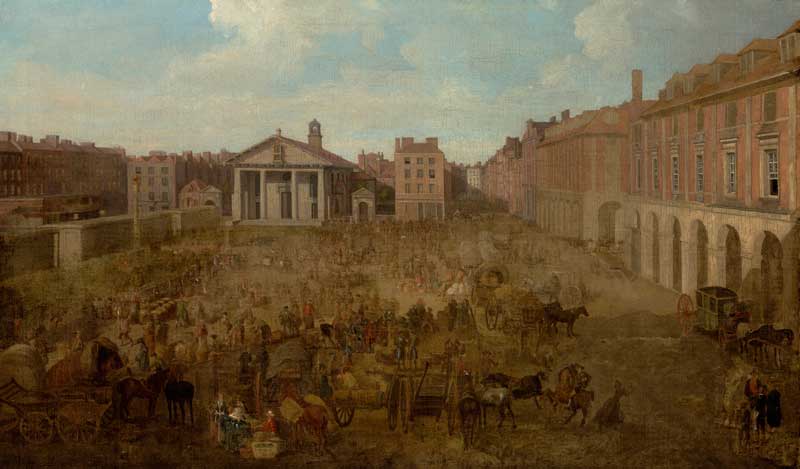 This fine 18th-century view of London’s most famous market was painted by Samuel Scott, ‘England’s Canaletto’, in the late 1750s. The scene shows the market in the morning, and was taken from the window of Scott’s studio in the northern corner of the market square, in what is today the Royal Opera House. Scott painted this scene on a number of occasions, with larger versions in private collections and the Museum of London.
This fine 18th-century view of London’s most famous market was painted by Samuel Scott, ‘England’s Canaletto’, in the late 1750s. The scene shows the market in the morning, and was taken from the window of Scott’s studio in the northern corner of the market square, in what is today the Royal Opera House. Scott painted this scene on a number of occasions, with larger versions in private collections and the Museum of London.
The Spencer House Chairs, attributed to John Gordon to designs by James ‘Athenian’ Stuart. Mallett, London
 This pair of George II carved armchairs were probably supplied by John Gordon to designs by James ‘Athenian’ Stuart, the English archaeologist, architect and artist. They were commissioned between 1758 and 1765 by John Spencer, 1st Earl Spencer, for his new private palace in London. Stuart also created the Painted Room at Spencer House, which survives as one of the most celebrated 18th-century interiors in the UK.
This pair of George II carved armchairs were probably supplied by John Gordon to designs by James ‘Athenian’ Stuart, the English archaeologist, architect and artist. They were commissioned between 1758 and 1765 by John Spencer, 1st Earl Spencer, for his new private palace in London. Stuart also created the Painted Room at Spencer House, which survives as one of the most celebrated 18th-century interiors in the UK.
Londinium Feracissmi Angliae Regni Metropolis (published 1574), Georg Braun and Franz Hogenberg. Daniel Crouch Rare Books, London
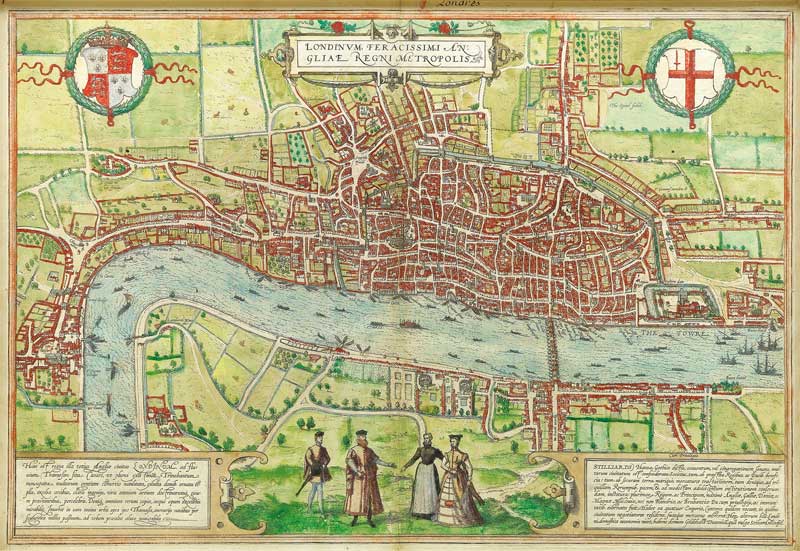 This is the earliest extant plan of London, depicted in bird’s-eye view from the south looking north. Although published in 1572, the plan is based upon information gathered some years earlier. St Paul’s is shown with its spire, which was destroyed in 1561. On the south bank of the river is the new district of Southwark, with its theatres, and bull and bear baiting pits. The view derives from a 15-sheet plan, of which only three plates have survived.
This is the earliest extant plan of London, depicted in bird’s-eye view from the south looking north. Although published in 1572, the plan is based upon information gathered some years earlier. St Paul’s is shown with its spire, which was destroyed in 1561. On the south bank of the river is the new district of Southwark, with its theatres, and bull and bear baiting pits. The view derives from a 15-sheet plan, of which only three plates have survived.
A pair of wine coolers, c. 1862, Elkington & Co. Butchoff Antiques, London
Part of a dessert service exhibited at the Great Exhibition of 1862, it is to be noted that as Elkington & Co. were on the judging committee they were ineligible to receive prizes, but the jury remarked: ‘The dessert service has great merit…and the effect is very beautiful.’ Elkington & Company was founded by brothers George and Henry in 1832, after perfecting their newly patented method of electroplating in gold and silver, for which their first patent was granted in 1840.
Masterpiece London takes place in the South Grounds of the Royal Hospital Chelsea, from 26 June–2 July 2014.
This selection was first published in Masterpiece London magazine 2014, in association with Apollo.
